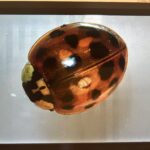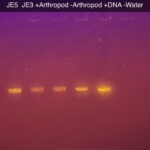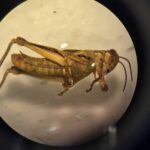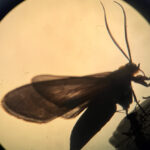Sample information |
|
| Picture |



|
|---|---|
| Location | |
| Collection date | 02/09/2025 |
| Captive / Cultivated? | Captive / Cultivated |
| Group | Berkshire Community College |
| Observations | Ladybird beetle found crawing on a windowsill inside a house. |
| Putative identification | Arthropoda |
Methods |
|
| Extraction kit | Monarch DNA extraction (NEB) |
| DNA extraction location | body without wings |
| Single or Duplex PCR | Single Reaction |
| Gel electrophoresis system | Edvotek Gel Electrophoresis |
| Buffer | TAE |
| DNA stain | SYBR Safe |
| Gel images |


|
| Protocol notes | JE5 = Lamyctes emarginatus JE3 = Genus Harmonia Taq polymerase used: New England Biolavs OneTaq Hot Start Quick-Load 2xx MM w/ Standard Buffer (Product #M0488S) DNA Ladder used: New England Biolabs 1kb Plus DNA Ladder for Safe Stains (product #N0559S) PCR 1- Date: 3/6/2025 Primer: Arthopod Annealing Temperature: 49C PCR 2- Date : 4/3/2025. Primers – Wolbachia. Annealing Temperature: 55C
|
Results |
|
| Wolbachia presence | No |
| Confidence level | Medium |
| Explanation of confidence level | Wolbachia is pretty common in arthropods and lady beetles. The controls did work because the controls that needed a band had bands. The confidence level is medium because the (+) Arthropod was faint, so when doing the first PCR the bands were clearly displayed and when did the second PCR the bands appeared faintly. |
| Wolbachia 16S sequence | |
| Arthropod COI sequence | Download AB1
NNNTTNNTTTTGNNNTATGGGCAGGAATAGTAGGAACATCGTTAAGTATTTTAATTCGGTTAGAATTAGGAACTAGAGGA AGATTAATTGGAAACGACCAAATTTATAATATAATTGTTACAGCTCATGCTTTCATTATAATTTTCTTTATAGTAATACC TATTATAATTGGGGGTTTTGGAAATTGATTAGTTCCTTTAATAATTGGAGCTCCTGATATAGCATTTCCACGATTAAATA ACATAAGATTTTGACTTTTACCCCCTGCTTTAACTCTTTTAATTTTAAGAACAATCGTAGAAATAGGGGCAGGAACAGGA TGAACTGTTTACCCTCCTCTTTCTTCTAATTTAACACATAATGGGCCTTCAGTAGATTTAGTGATTTTTAGTTTACATTT AGCAGGAATTTCCTCAATTTTAGGTGCAGTAAATTTCATTTCAACTATTATAAATATACGTCCATTTGGTATAATACTTG ATAAAACTCCTTTATTTGTATGATCTGTTCTTATTACAGCAATTCTTTTATTACTATCACTACCAGTTCTTGCAGGAGCA ATTACTATACTATTAACTGACCGAAACTTAAATTCTTCTTTTTTTGACNNAACNNGTGGGGGAGACCCAATTTTATACCA ACATTTATTTTGATTTTTTGNTNNNNNNNNANNTTAAA
BLAST at The Wolbachia Project BLAST at NCBI
|
| Summary | The Arthropoda was found to be negative for Wolbachia. |
 Differential Grasshopper – Melanoplus differentialis
Differential Grasshopper – Melanoplus differentialis Pill Bug (Armadillidium vulgare) – Draft
Pill Bug (Armadillidium vulgare) – Draft Melanoplus Femurrubrum
Melanoplus Femurrubrum Grasshopper – Orthoptera
Grasshopper – Orthoptera Cisseps Fulvicollis
Cisseps Fulvicollis